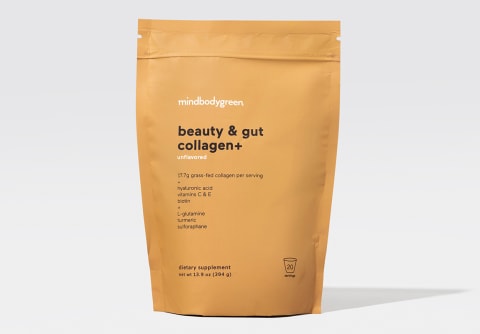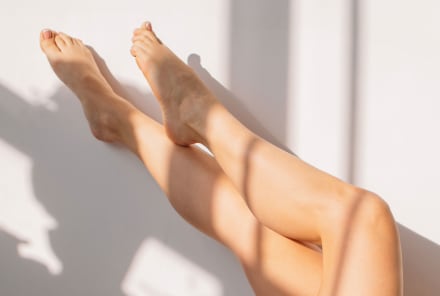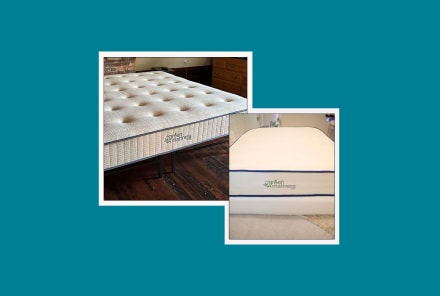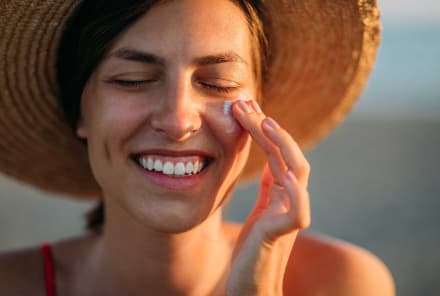Advertisement
A Tried-And-Tested Routine To Stop Dark Spots In Their Tracks

Hannah Frye is the Assistant Beauty Editor at mindbodygreen. She has a B.S. in journalism and a minor in women’s, gender, and queer studies from California Polytechnic State University, San Luis Obispo. Hannah has written across lifestyle sections including health, wellness, sustainability, personal development, and more.

I recently returned from a weeklong trip to sunny California. On my return flight, I brought back a bottle of California Pinot Noir, a handmade ceramic mug, and in less exciting news, plenty of dark spots.
With my fair skin and love for the sun, this didn't surprise me—I've been freckle-prone my entire life. But thanks to my years of skin care knowledge, I managed to fade many of the discolored spots, revive my skin's elasticity, and replenish moisture, all within a week of returning to New York City.
Up next, I'll share my go-to sun care routine (including pre- and post-sun exposure) and explain why it works.
Pre-sun
First, a few things you should consider before spending a long day in the sun—be it swimming, hiking, or picnicking, etc.:
1. Skip the retinol & chemical exfoliants
If you regularly exfoliate your skin or use retinol (both excellent for fine lines and skin texture), it's best to hold off before a sunny day.
These products can sensitize your skin, making it more prone to irritation and burns. While some people can use them in the days leading up to sun exposure without issue, it's safer to build up your skin barrier for a few days.
Instead of using these actives, rely on hydrating serums with ingredients like peptides, ceramides, and hyaluronic acid. Layer on a nourishing face cream (our favorite nourishing options here). This way, your skin's defenses will be well established before facing the sun.
2. Apply (reapply, and reapply again) SPF
It goes without saying: You should apply and reapply sunscreen throughout the day during long sun exposure. Dermatologists recommend reapplying every two hours if you're in direct sunlight, sweating, or swimming.
At the end of a long day in the sun, be sure to double-cleanse (using oil or micellar water before your water-based cleanser) to break down the stubborn SPF, especially if you're acne-prone.
Post-sun:
Once you've spent your time outside (hopefully with a hat of some kind), it's time to kick into repair mode. Below, three steps to consider:
1. Hydrate, hydrate, hydrate
After sun exposure, your skin will naturally try to repair itself (what a magical organ!). Your job is to create a path of least resistance for optimal healing, starting with hydration. Use the barrier-supporting skin care routine you followed pre-sun for a day or two afterward as well.
You can also enhance your routine with a hydrating face mask. My favorites for this are the Danucera Master Mask and the First Aid Beauty Ultra Repair Instant Oatmeal Mask.
2. Exfoliate (a few days later)
After a few days of skin TLC, you'll want to exfoliate. Dead skin buildup can occur, so removing it will reveal a fresh complexion and help prevent clogged pores.
You can choose a chemical exfoliant like a gentle mandelic acid serum or a more powerful multi-acid mask. Alternatively, you may opt for a physical exfoliant with soft granules, but it's best to avoid harsh salt scrubs on the face.
If you already have an exfoliating product you love, it's likely safe to use it a day or two post-sun exposure. However, if you have a sunburn, even a slight one, wait until the redness and sensitivity have fully subsided before exfoliating. When in doubt, patch test on your cheek.
3. Boost your collagen bank
It's unfortunate that the sun depletes our collagen supply, but it's a truth worth addressing sooner rather than later. In fact, 80% of visible signs of skin aging stem from sun exposure1. Coupled with the natural 1% annual decline in collagen production2 after your mid-20s and 30% decline3 in the first five years of menopause, skin aging can accelerate rapidly.
Aside from your topical skin care routine, it's crucial to support your collagen levels from the inside out, which means considering collagen supplements. To avoid ineffective products on the market, here are some nonnegotiables:
- Hydrolyzed collagen peptides: This form is easiest to digest and thus easiest for your body to use.
- Additional skin-loving ingredients: Look for hyaluronic acid, ceramides, astaxanthin, vitamins C and E, and other skin-boosting ingredients to make your product worth the money.
- No fillers, dyes, or added sugars: If you're going to take a powder supplement every day (and you should when it comes to collagen), you'll want to skip added fillers, sugars, and dyes. Instead, reach for naturally sweet formulas that use monkfruit or coconut sugar to enhance flavor.
I know, it can be a lot to remember, so here's our carefully curated list of the best collagen supplements on the market for easy browsing.
The takeaway
The unfortunate truth is that UV rays, as great as they feel, can damage your skin and accelerate visible skin aging.
To combat this, it's essential to keep a well-rounded sun care routine including SPF, topical hydration, collagen supplementation, and so on. For more sun care tips, check out this guide.
Watch Next
Enjoy some of our favorite clips from classes
Enjoy some of our favorite clips from classes
What Is Meditation?
Mindfulness/Spirituality | Light Watkins
Box Breathing
Mindfulness/Spirituality | Gwen Dittmar
What Breathwork Can Address
Mindfulness/Spirituality | Gwen Dittmar
The 8 Limbs of Yoga - What is Asana?
Yoga | Caley Alyssa
Two Standing Postures to Open Up Tight Hips
Yoga | Caley Alyssa
How Plants Can Optimize Athletic Performance
Nutrition | Rich Roll
What to Eat Before a Workout
Nutrition | Rich Roll
How Ayurveda Helps Us Navigate Modern Life
Nutrition | Sahara Rose
Messages About Love & Relationships
Love & Relationships | Esther Perel
Love Languages
Love & Relationships | Esther Perel


















